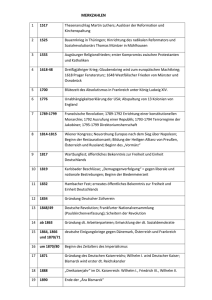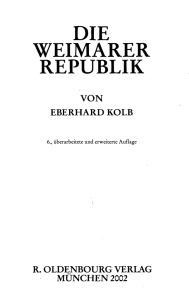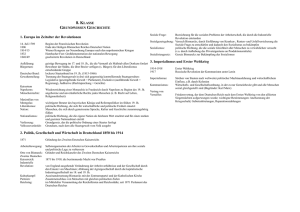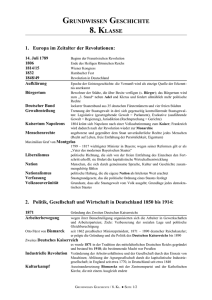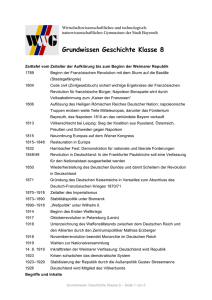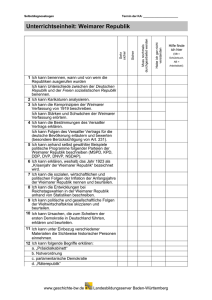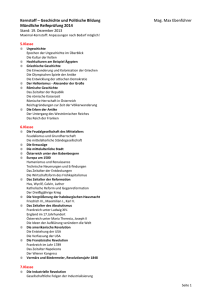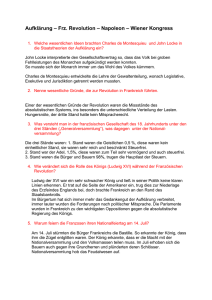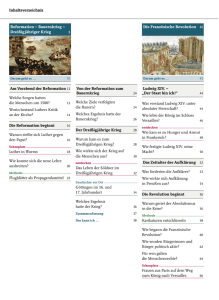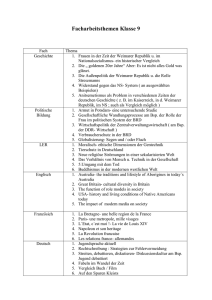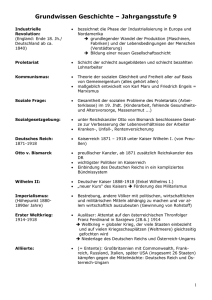Inhalt - STARK Verlag
Werbung
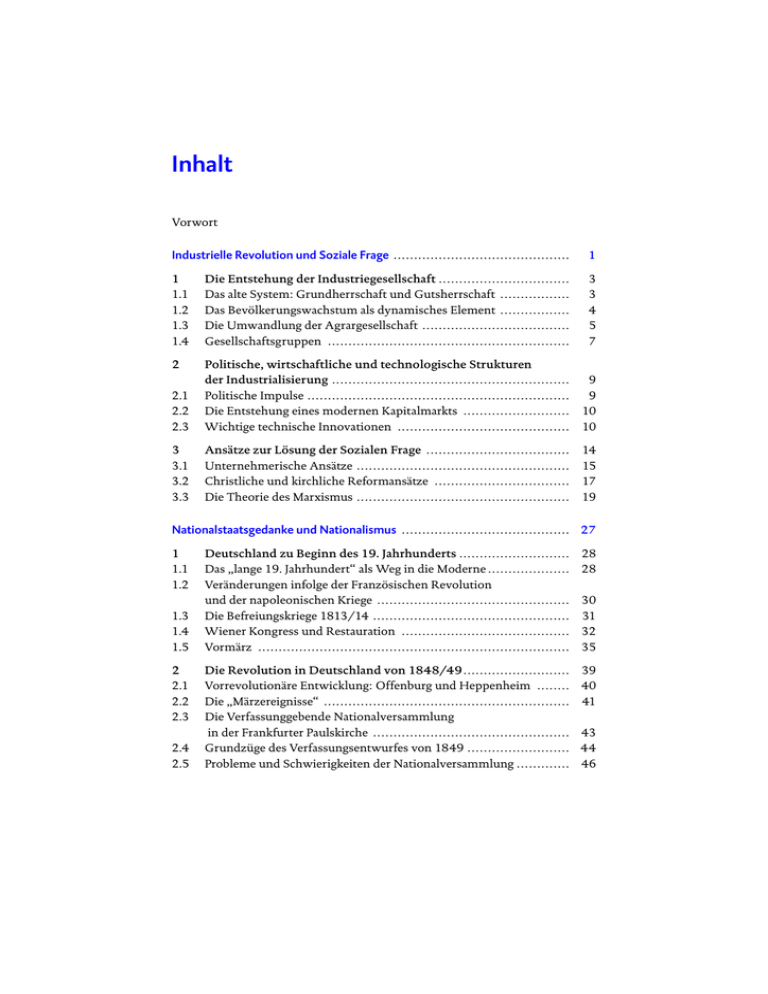
Inhalt Vorwort Industrielle Revolution und Soziale Frage . . . . . . . . . . . . . . . . . . . . . . . . . . . . . . . . . . . . . . . . . . . 1 1 1.1 1.2 1.3 1.4 Die Entstehung der Industriegesellschaft . . . . . . . . . . . . . . . . . . . . . . . . . . . . . . . . Das alte System: Grundherrschaft und Gutsherrschaft . . . . . . . . . . . . . . . . . Das Bevölkerungswachstum als dynamisches Element . . . . . . . . . . . . . . . . . Die Umwandlung der Agrargesellschaft . . . . . . . . . . . . . . . . . . . . . . . . . . . . . . . . . . . . Gesellschaftsgruppen . . . . . . . . . . . . . . . . . . . . . . . . . . . . . . . . . . . . . . . . . . . . . . . . . . . . . . . . . . . 3 3 4 5 7 2 2.1 2.2 2.3 Politische, wirtschaftliche und technologische Strukturen der Industrialisierung . . . . . . . . . . . . . . . . . . . . . . . . . . . . . . . . . . . . . . . . . . . . . . . . . . . . . . . . . . Politische Impulse . . . . . . . . . . . . . . . . . . . . . . . . . . . . . . . . . . . . . . . . . . . . . . . . . . . . . . . . . . . . . . . . Die Entstehung eines modernen Kapitalmarkts . . . . . . . . . . . . . . . . . . . . . . . . . . Wichtige technische Innovationen . . . . . . . . . . . . . . . . . . . . . . . . . . . . . . . . . . . . . . . . . . 9 9 10 10 3 3.1 3.2 3.3 Ansätze zur Lösung der Sozialen Frage . . . . . . . . . . . . . . . . . . . . . . . . . . . . . . . . . . . Unternehmerische Ansätze . . . . . . . . . . . . . . . . . . . . . . . . . . . . . . . . . . . . . . . . . . . . . . . . . . . . Christliche und kirchliche Reformansätze . . . . . . . . . . . . . . . . . . . . . . . . . . . . . . . . . Die Theorie des Marxismus . . . . . . . . . . . . . . . . . . . . . . . . . . . . . . . . . . . . . . . . . . . . . . . . . . . . 14 15 17 19 Nationalstaatsgedanke und Nationalismus . . . . . . . . . . . . . . . . . . . . . . . . . . . . . . . . . . . . . . . . . 27 1 1.1 1.2 1.3 1.4 1.5 2 2.1 2.2 2.3 2.4 2.5 Deutschland zu Beginn des 19. Jahrhunderts . . . . . . . . . . . . . . . . . . . . . . . . . . . Das „lange 19. Jahrhundert“ als Weg in die Moderne . . . . . . . . . . . . . . . . . . . . Veränderungen infolge der Französischen Revolution und der napoleonischen Kriege . . . . . . . . . . . . . . . . . . . . . . . . . . . . . . . . . . . . . . . . . . . . . . . Die Befreiungskriege 1813/14 . . . . . . . . . . . . . . . . . . . . . . . . . . . . . . . . . . . . . . . . . . . . . . . . Wiener Kongress und Restauration . . . . . . . . . . . . . . . . . . . . . . . . . . . . . . . . . . . . . . . . . Vormärz . . . . . . . . . . . . . . . . . . . . . . . . . . . . . . . . . . . . . . . . . . . . . . . . . . . . . . . . . . . . . . . . . . . . . . . . . . . . 28 28 30 31 32 35 Die Revolution in Deutschland von 1848/49 . . . . . . . . . . . . . . . . . . . . . . . . . . 39 Vorrevolutionäre Entwicklung: Offenburg und Heppenheim . . . . . . . . 40 Die „Märzereignisse“ . . . . . . . . . . . . . . . . . . . . . . . . . . . . . . . . . . . . . . . . . . . . . . . . . . . . . . . . . . . . 41 Die Verfassunggebende Nationalversammlung in der Frankfurter Paulskirche . . . . . . . . . . . . . . . . . . . . . . . . . . . . . . . . . . . . . . . . . . . . . . . . 43 Grundzüge des Verfassungsentwurfes von 1849 . . . . . . . . . . . . . . . . . . . . . . . . . 44 Probleme und Schwierigkeiten der Nationalversammlung . . . . . . . . . . . . . 46 Das Kaiserreich . . . . . . . . . . . . . . . . . . . . . . . . . . . . . . . . . . . . . . . . . . . . . . . . . . . . . . . . . . . . . . . . . . . . . . . . . . . . 53 Der Weg zur Reichsgründung (1848 –1871) . . . . . . . . . . . . . . . . . . . . . . . . . . . Das Wiedererstarken der monarchischen Herrschaft nach 1849 . . . . . Der preußisch-österreichische Dualismus und die Einigungskriege (1864 –1870) . . . . . . . . . . . . . . . . . . . . . . . . . . . . . . . . . . . . . 56 57 2 Die Reichsverfassung von 1871 . . . . . . . . . . . . . . . . . . . . . . . . . . . . . . . . . . . . . . . . . . . . 66 3 3.1 3.2 3.3 3.4 Bismarcks Innenpolitik . . . . . . . . . . . . . . . . . . . . . . . . . . . . . . . . . . . . . . . . . . . . . . . . . . . . . . . . Der Kulturkampf gegen den politischen Katholizismus . . . . . . . . . . . . . . . . Die konservative Wende Bismarcks nach 1878 . . . . . . . . . . . . . . . . . . . . . . . . . . . Der neue „Staatsfeind“: Die Sozialdemokratie . . . . . . . . . . . . . . . . . . . . . . . . . . . . . Bismarcks Sozialgesetzgebung . . . . . . . . . . . . . . . . . . . . . . . . . . . . . . . . . . . . . . . . . . . . . . . . 69 70 72 72 74 4 4.1 4.2 4.3 Die Innenpolitik Wilhelms II. (1888 –1918) . . . . . . . . . . . . . . . . . . . . . . . . . . . Das persönliche Regiment Wilhelms II. . . . . . . . . . . . . . . . . . . . . . . . . . . . . . . . . . . . . Militarismus und Sozialimperialismus . . . . . . . . . . . . . . . . . . . . . . . . . . . . . . . . . . . . . . Die Entwicklung von Parteien, Verbänden, Vereinen und Gewerkschaften . . . . . . . . . . . . . . . . . . . . . . . . . . . . . . . . . . . . . . . . . . . . . . . . 76 76 76 77 Die Außenpolitik des Deutschen Reiches (1871–1914) . . . . . . . . . . . . Die Ausgangssituation . . . . . . . . . . . . . . . . . . . . . . . . . . . . . . . . . . . . . . . . . . . . . . . . . . . . . . . . . . Die Außenpolitik Bismarcks . . . . . . . . . . . . . . . . . . . . . . . . . . . . . . . . . . . . . . . . . . . . . . . . . . . Die Außenpolitik unter Wilhelm II. (1890 –1914) . . . . . . . . . . . . . . . . . . . . . . . Internationale Krisen . . . . . . . . . . . . . . . . . . . . . . . . . . . . . . . . . . . . . . . . . . . . . . . . . . . . . . . . . . . . Die Situation in Europa vor dem Ersten Weltkrieg . . . . . . . . . . . . . . . . . . . . . . 79 80 81 85 88 90 1 1.1 1.2 5 5.1 5.2 5.3 5.4 5.5 61 Imperialismus . . . . . . . . . . . . . . . . . . . . . . . . . . . . . . . . . . . . . . . . . . . . . . . . . . . . . . . . . . . . . . . . . . . . . . . . . . . . . 95 1 1.1 1.2 Motive und Ziele imperialistischer Politik . . . . . . . . . . . . . . . . . . . . . . . . . . . . . . . Imperialistische Herrschaftsformen . . . . . . . . . . . . . . . . . . . . . . . . . . . . . . . . . . . . . . . . . Imperialismus-Theorien . . . . . . . . . . . . . . . . . . . . . . . . . . . . . . . . . . . . . . . . . . . . . . . . . . . . . . . . 96 96 97 2 2.1 2.2 2.3 2.4 2.5 2.6 2.7 Die Großmächte im Zeitalter des Imperialismus . . . . . . . . . . . . . . . . . . . . . . Großbritannien . . . . . . . . . . . . . . . . . . . . . . . . . . . . . . . . . . . . . . . . . . . . . . . . . . . . . . . . . . . . . . . . . . . Frankreich . . . . . . . . . . . . . . . . . . . . . . . . . . . . . . . . . . . . . . . . . . . . . . . . . . . . . . . . . . . . . . . . . . . . . . . . . . Das Deutsche Reich . . . . . . . . . . . . . . . . . . . . . . . . . . . . . . . . . . . . . . . . . . . . . . . . . . . . . . . . . . . . . . Russland . . . . . . . . . . . . . . . . . . . . . . . . . . . . . . . . . . . . . . . . . . . . . . . . . . . . . . . . . . . . . . . . . . . . . . . . . . . . Österreich-Ungarn . . . . . . . . . . . . . . . . . . . . . . . . . . . . . . . . . . . . . . . . . . . . . . . . . . . . . . . . . . . . . . . Japan . . . . . . . . . . . . . . . . . . . . . . . . . . . . . . . . . . . . . . . . . . . . . . . . . . . . . . . . . . . . . . . . . . . . . . . . . . . . . . . . . USA . . . . . . . . . . . . . . . . . . . . . . . . . . . . . . . . . . . . . . . . . . . . . . . . . . . . . . . . . . . . . . . . . . . . . . . . . . . . . . . . . . 99 100 103 104 105 107 108 109 3 Die Auswirkungen des Imperialismus auf China und das Osmanische Reich . . . . . . . . . . . . . . . . . . . . . . . . . . . . . . . . . . . . . 111 China . . . . . . . . . . . . . . . . . . . . . . . . . . . . . . . . . . . . . . . . . . . . . . . . . . . . . . . . . . . . . . . . . . . . . . . . . . . . . . . . 111 Das Osmanische Reich (Türkei) . . . . . . . . . . . . . . . . . . . . . . . . . . . . . . . . . . . . . . . . . . . . . . 114 3.1 3.2 Der Erste Weltkrieg . . . . . . . . . . . . . . . . . . . . . . . . . . . . . . . . . . . . . . . . . . . . . . . . . . . . . . . . . . . . . . . . . . . . . . 119 1 Die Julikrise 1914 . . . . . . . . . . . . . . . . . . . . . . . . . . . . . . . . . . . . . . . . . . . . . . . . . . . . . . . . . . . . . . . 121 2 2.1 2.2 2.3 2.4 2.5 2.6 2.7 Kriegsverlauf . . . . . . . . . . . . . . . . . . . . . . . . . . . . . . . . . . . . . . . . . . . . . . . . . . . . . . . . . . . . . . . . . . . . . . Die Ausgangslage . . . . . . . . . . . . . . . . . . . . . . . . . . . . . . . . . . . . . . . . . . . . . . . . . . . . . . . . . . . . . . . . . Scheitern des Schlieffen-Plans, Stellungskrieg und „Materialschlachten“ im Westen . . . . . . . . . . . . . . . . . . . . . . . . . . . . . . . . . . . . . . . „Abnutzungsschlachten“ 1916/1917 (Verdun, Somme) . . . . . . . . . . . . . . . Britische Seeblockade und deutscher U-Bootkrieg . . . . . . . . . . . . . . . . . . . . . . . Die Entwicklung im Osten . . . . . . . . . . . . . . . . . . . . . . . . . . . . . . . . . . . . . . . . . . . . . . . . . . . . . Der Kriegseintritt Italiens und die Entwicklung auf dem Balkan . . . . . Die Kriegsentscheidung im Westen 1918 . . . . . . . . . . . . . . . . . . . . . . . . . . . . . . . . . . 124 127 127 128 128 129 3 3.1 3.2 3.3 Innenpolitik . . . . . . . . . . . . . . . . . . . . . . . . . . . . . . . . . . . . . . . . . . . . . . . . . . . . . . . . . . . . . . . . . . . . . . . Die Spaltung der SPD . . . . . . . . . . . . . . . . . . . . . . . . . . . . . . . . . . . . . . . . . . . . . . . . . . . . . . . . . . . . Verspätete Reformen . . . . . . . . . . . . . . . . . . . . . . . . . . . . . . . . . . . . . . . . . . . . . . . . . . . . . . . . . . . . Der totale Krieg: Wirtschaft und Alltagsleben . . . . . . . . . . . . . . . . . . . . . . . . . . . . 130 132 132 133 123 124 Die Weimarer Republik . . . . . . . . . . . . . . . . . . . . . . . . . . . . . . . . . . . . . . . . . . . . . . . . . . . . . . . . . . . . . . . . . 137 1 1.1 1.2 Bestimmende politische und gesellschaftliche Strukturen . . . . . . . . . 139 Die Klassengesellschaft . . . . . . . . . . . . . . . . . . . . . . . . . . . . . . . . . . . . . . . . . . . . . . . . . . . . . . . . . 139 Die Modernisierungskrise . . . . . . . . . . . . . . . . . . . . . . . . . . . . . . . . . . . . . . . . . . . . . . . . . . . . . . 140 2 2.1 2.2 2.3 2.4 Die Revolution von 1918 . . . . . . . . . . . . . . . . . . . . . . . . . . . . . . . . . . . . . . . . . . . . . . . . . . . . . „Oktoberverfassung“: verspätete Parlamentarisierung des Reichs . . . . . . . . . . . . . . . . . . . . . . . . . . . . . . . . . Die Revolution der Soldaten und Arbeiter . . . . . . . . . . . . . . . . . . . . . . . . . . . . . . . . . Der Weg zur Nationalversammlung . . . . . . . . . . . . . . . . . . . . . . . . . . . . . . . . . . . . . . . . . Demokratische Alternativen in der revolutionären Anfangsphase? . . 142 142 144 145 3 3.1 3.2 3.3 3.4 3.5 3.6 Die Weimarer Reichsverfassung von 1919 . . . . . . . . . . . . . . . . . . . . . . . . . . . . . . Zentralismus und Föderalismus . . . . . . . . . . . . . . . . . . . . . . . . . . . . . . . . . . . . . . . . . . . . . . Wahlsystem und plebiszitäre Elemente . . . . . . . . . . . . . . . . . . . . . . . . . . . . . . . . . . . . Der Reichspräsident . . . . . . . . . . . . . . . . . . . . . . . . . . . . . . . . . . . . . . . . . . . . . . . . . . . . . . . . . . . . . Die Reichsregierung . . . . . . . . . . . . . . . . . . . . . . . . . . . . . . . . . . . . . . . . . . . . . . . . . . . . . . . . . . . . . Grundrechte und Grundpflichten . . . . . . . . . . . . . . . . . . . . . . . . . . . . . . . . . . . . . . . . . . . Die Parteien in der Nationalversammlung 1919 . . . . . . . . . . . . . . . . . . . . . . . . . . 146 147 148 149 150 150 152 4 4.1 4.2 4.3 Der Vertrag von Versailles mit Deutschland 1919 . . . . . . . . . . . . . . . . . . . . Die Interessen der wichtigsten Siegermächte . . . . . . . . . . . . . . . . . . . . . . . . . . . . . . Kernpunkte des Vertrags . . . . . . . . . . . . . . . . . . . . . . . . . . . . . . . . . . . . . . . . . . . . . . . . . . . . . . . Folgen des Versailler Vertrags . . . . . . . . . . . . . . . . . . . . . . . . . . . . . . . . . . . . . . . . . . . . . . . . . 154 154 155 157 141 5 5.1 5.2 5.3 5.4 5.5 Die Außenpolitik der Weimarer Republik . . . . . . . . . . . . . . . . . . . . . . . . . . . . . . Der Vertrag von Rapallo 1922 . . . . . . . . . . . . . . . . . . . . . . . . . . . . . . . . . . . . . . . . . . . . . . . . Die Locarno-Verträge 1925. . . . . . . . . . . . . . . . . . . . . . . . . . . . . . . . . . . . . . . . . . . . . . . . . . . . . Der Berliner Vertrag 1926 . . . . . . . . . . . . . . . . . . . . . . . . . . . . . . . . . . . . . . . . . . . . . . . . . . . . . . Der Eintritt in den Völkerbund 1926 . . . . . . . . . . . . . . . . . . . . . . . . . . . . . . . . . . . . . . . . Die Entwicklung der Reparationsfrage . . . . . . . . . . . . . . . . . . . . . . . . . . . . . . . . . . . . . . 159 160 160 161 161 162 6 6.1 6.2 6.3 Rechte und linke Bedrohung der Republik . . . . . . . . . . . . . . . . . . . . . . . . . . . . . . Kapp-Lüttwitz-Putsch und Ruhraufstand 1920 . . . . . . . . . . . . . . . . . . . . . . . . . . Das Krisenjahr 1923 . . . . . . . . . . . . . . . . . . . . . . . . . . . . . . . . . . . . . . . . . . . . . . . . . . . . . . . . . . . . . Die Wahl Hindenburgs zum Reichspräsidenten 1925 als Wendepunkt der Weimarer Republik . . . . . . . . . . . . . . . . . . . . . . . . . . . . . . . . . . . 163 164 165 7 7.1 7.2 7.3 Die Weltwirtschaftskrise von 1929 und ihre Folgen . . . . . . . . . . . . . . . . . Der Zusammenbruch der Weltwirtschaft . . . . . . . . . . . . . . . . . . . . . . . . . . . . . . . . . . Die innenpolitischen Folgen . . . . . . . . . . . . . . . . . . . . . . . . . . . . . . . . . . . . . . . . . . . . . . . . . . . Scheitern der Republik in den Präsidialkabinetten 1930 –1933 . . . . . . 170 170 171 174 8 Gründe für das Scheitern der Weimarer Republik . . . . . . . . . . . . . . . . . . . . 179 168 Deutschland im Nationalsozialismus . . . . . . . . . . . . . . . . . . . . . . . . . . . . . . . . . . . . . . . . . . . . . . . . . 187 1 1.1 1.2 1.3 1.4 2 Die „Machtergreifung“ . . . . . . . . . . . . . . . . . . . . . . . . . . . . . . . . . . . . . . . . . . . . . . . . . . . . . . . . . Koalitionsregierung der „Nationalen Erhebung“ . . . . . . . . . . . . . . . . . . . . . . . . . . Die Zerschlagung des Rechtsstaates („Notverordnung zum Schutz von Volk und Staat“, 28. 2. 1933) . . . . . . . . . . . . . . . . . . . . . . . . . . . . Die „nationale Revolution“ nach den Reichstagswahlen (5. 3. 1933) . . . . . . . . . . . . . . . . . . . . . . . . . . . . . . . . . . . . Die Selbstausschaltung des Reichstags im „Ermächtigungsgesetz“ (23. 3. 1933). . . . . . . . . . . . . . . . . . . . . . . . . . . . . . . . . . . . . . . . . . . . . . . . . . . . . . . . . . . . . . . . . . . . . . . . 190 190 191 192 192 2.6 2.7 Die „Gleichschaltung“ von Politik, Verwaltung und Reichswehr . . . . . . . . . . . . . . . . . . . . . . . . . . . . . . . . Die Säuberung des Beamtenapparates und der Universitäten . . . . . . . . . Die Selbstunterwerfung der Justiz . . . . . . . . . . . . . . . . . . . . . . . . . . . . . . . . . . . . . . . . . . . Die Beseitigung des Föderalismus . . . . . . . . . . . . . . . . . . . . . . . . . . . . . . . . . . . . . . . . . . . . Das Verbot der Parteien . . . . . . . . . . . . . . . . . . . . . . . . . . . . . . . . . . . . . . . . . . . . . . . . . . . . . . . . . Ausschalten innerparteilicher und konservativer Rivalen („Röhm-Putsch“) . . . . . . . . . . . . . . . . . . . . . . . . . . . . . . . . . . . . . . . . . . . . . . . . . . . . . . . . . . . . . . . . . Die Unterordnung der Reichswehr . . . . . . . . . . . . . . . . . . . . . . . . . . . . . . . . . . . . . . . . . . Die Festigung der Macht . . . . . . . . . . . . . . . . . . . . . . . . . . . . . . . . . . . . . . . . . . . . . . . . . . . . . . . . 3 3.1 3.2 Die Gleichschaltung der Gesellschaft . . . . . . . . . . . . . . . . . . . . . . . . . . . . . . . . . . . . . 200 Die Kontrolle des Kultursystems . . . . . . . . . . . . . . . . . . . . . . . . . . . . . . . . . . . . . . . . . . . . . 200 Die Einflussnahme auf die christlichen Kirchen . . . . . . . . . . . . . . . . . . . . . . . . . . 201 2.1 2.2 2.3 2.4 2.5 194 194 195 195 196 196 198 198 4 4.1 4.2 4.3 4.4 4.5 4.6 Die Grundzüge der NS-Ideologie . . . . . . . . . . . . . . . . . . . . . . . . . . . . . . . . . . . . . . . . . . . Rassismus als pseudo-wissenschaftliche Grundlage . . . . . . . . . . . . . . . . . . . . . Antisemitismus als ideologischer Kern . . . . . . . . . . . . . . . . . . . . . . . . . . . . . . . . . . . . . Lebensraumpolitik als außenpolitische Folgerung . . . . . . . . . . . . . . . . . . . . . . . Hitlers „Nationaler Sozialismus“ . . . . . . . . . . . . . . . . . . . . . . . . . . . . . . . . . . . . . . . . . . . . . . Radikaler Bruch mit den Werten der Aufklärung . . . . . . . . . . . . . . . . . . . . . . . . Das „Dritte Reich“ als mythischer Bezugspunkt des Nationalsozialismus . . . . . . . . . . . . . . . . . . . . . . . . . . . . . . . . . . . . . . . . . . . . . . . . . . . . . . . . Das Führerprinzip . . . . . . . . . . . . . . . . . . . . . . . . . . . . . . . . . . . . . . . . . . . . . . . . . . . . . . . . . . . . . . . . 202 203 204 204 205 205 208 208 209 212 214 215 216 220 5.9 Die Herrschaftsinstrumente des NS-Regimes . . . . . . . . . . . . . . . . . . . . . . . . . . Der Führermythos . . . . . . . . . . . . . . . . . . . . . . . . . . . . . . . . . . . . . . . . . . . . . . . . . . . . . . . . . . . . . . . Die Verschränkung von Partei und Staat im „Führerstaat“ . . . . . . . . . . . . . Die nationalsozialistische Durchdringung der Gesellschaft . . . . . . . . . . . . Propaganda . . . . . . . . . . . . . . . . . . . . . . . . . . . . . . . . . . . . . . . . . . . . . . . . . . . . . . . . . . . . . . . . . . . . . . . . . Kulturelle „Verführung“ (NS-Kulturpolitik) . . . . . . . . . . . . . . . . . . . . . . . . . . . . . . . Politische Unterdrückung . . . . . . . . . . . . . . . . . . . . . . . . . . . . . . . . . . . . . . . . . . . . . . . . . . . . . . Der SS-Staat . . . . . . . . . . . . . . . . . . . . . . . . . . . . . . . . . . . . . . . . . . . . . . . . . . . . . . . . . . . . . . . . . . . . . . . Wertekonsens zwischen Konservativen und dem Nationalsozialisten . . . . . . . . . . . . . . . . . . . . . . . . . . . . . . Die Korrumpierung großer Bevölkerungsgruppen . . . . . . . . . . . . . . . . . . . . . . 6 6.1 6.2 6.3 6.4 6.5 Die nationalsozialistische Wirtschaftspolitik . . . . . . . . . . . . . . . . . . . . . . . . . . Das NS-„Wirtschaftswunder“ . . . . . . . . . . . . . . . . . . . . . . . . . . . . . . . . . . . . . . . . . . . . . . . . . Die Rolle der Wirtschaft im NS-System . . . . . . . . . . . . . . . . . . . . . . . . . . . . . . . . . . . . Die Zerschlagung der Gewerkschaften . . . . . . . . . . . . . . . . . . . . . . . . . . . . . . . . . . . . . . Die Eingliederung in die staatliche Kommandowirtschaft . . . . . . . . . . . . . Die Verstrickung der Wirtschaft in den Eroberungskrieg . . . . . . . . . . . . . . 222 223 224 224 225 226 7 7.1 7.2 7.3 7.4 7.5 7.6 7.7 Die nationalsozialistische Außenpolitik . . . . . . . . . . . . . . . . . . . . . . . . . . . . . . . . . Hitlers außenpolitische Vorstellung . . . . . . . . . . . . . . . . . . . . . . . . . . . . . . . . . . . . . . . . . Die Kontinuität der Revisions- und Großmachtpolitik . . . . . . . . . . . . . . . . . Hitlers Doppelstrategie . . . . . . . . . . . . . . . . . . . . . . . . . . . . . . . . . . . . . . . . . . . . . . . . . . . . . . . . . Die Isolation Deutschlands . . . . . . . . . . . . . . . . . . . . . . . . . . . . . . . . . . . . . . . . . . . . . . . . . . . . Das Durchbrechen der Isolation . . . . . . . . . . . . . . . . . . . . . . . . . . . . . . . . . . . . . . . . . . . . . . Aggressive Revisionspolitik . . . . . . . . . . . . . . . . . . . . . . . . . . . . . . . . . . . . . . . . . . . . . . . . . . . Die Vorbereitung des Kriegs gegen Polen . . . . . . . . . . . . . . . . . . . . . . . . . . . . . . . . . . . 227 228 229 230 230 232 233 235 8 8.1 8.2 8.3 8.4 Der Zweite Weltkrieg . . . . . . . . . . . . . . . . . . . . . . . . . . . . . . . . . . . . . . . . . . . . . . . . . . . . . . . . . . Der Kriegsverlauf . . . . . . . . . . . . . . . . . . . . . . . . . . . . . . . . . . . . . . . . . . . . . . . . . . . . . . . . . . . . . . . . . Der Vernichtungskrieg . . . . . . . . . . . . . . . . . . . . . . . . . . . . . . . . . . . . . . . . . . . . . . . . . . . . . . . . . . Der „totale Krieg“ . . . . . . . . . . . . . . . . . . . . . . . . . . . . . . . . . . . . . . . . . . . . . . . . . . . . . . . . . . . . . . . . . Der Bombenkrieg . . . . . . . . . . . . . . . . . . . . . . . . . . . . . . . . . . . . . . . . . . . . . . . . . . . . . . . . . . . . . . . . . 239 241 245 246 247 4.7 5 5.1 5.2 5.3 5.4 5.5 5.6 5.7 5.8 206 207 219 220 8.5 8.6 Bevölkerungspolitik, Flucht und Vertreibung . . . . . . . . . . . . . . . . . . . . . . . . . . . . . 248 Besatzungspolitik und Widerstand . . . . . . . . . . . . . . . . . . . . . . . . . . . . . . . . . . . . . . . . . . 249 9 9.1 9.2 9.3 9.4 9.5 9.6 9.7 Deutscher Widerstand gegen den Nationalsozialismus . . . . . . . . . . . . . Bedingungen und Ausmaß des Widerstands . . . . . . . . . . . . . . . . . . . . . . . . . . . . . . Arbeiterwiderstand . . . . . . . . . . . . . . . . . . . . . . . . . . . . . . . . . . . . . . . . . . . . . . . . . . . . . . . . . . . . . . Selbstbehauptung und Opposition in den Kirchen . . . . . . . . . . . . . . . . . . . . . . Widerstand in den gesellschaftlichen Eliten . . . . . . . . . . . . . . . . . . . . . . . . . . . . . . . Jugendopposition . . . . . . . . . . . . . . . . . . . . . . . . . . . . . . . . . . . . . . . . . . . . . . . . . . . . . . . . . . . . . . . . Studentischer Widerstand (Die „Weiße Rose“) . . . . . . . . . . . . . . . . . . . . . . . . . . . Widerstand verschiedener Gruppen und Einzelner . . . . . . . . . . . . . . . . . . . . . 250 251 252 254 256 259 261 261 10 10.1 10.2 10.3 10.4 10.5 10.6 NS-Rassenpolitik und Holocaust . . . . . . . . . . . . . . . . . . . . . . . . . . . . . . . . . . . . . . . . . . . Die Bedeutung des Holocausts . . . . . . . . . . . . . . . . . . . . . . . . . . . . . . . . . . . . . . . . . . . . . . . . Die NS-Rassenpolitik bis Kriegsbeginn . . . . . . . . . . . . . . . . . . . . . . . . . . . . . . . . . . . . . Der Verlauf des Holocausts . . . . . . . . . . . . . . . . . . . . . . . . . . . . . . . . . . . . . . . . . . . . . . . . . . . . . Erklärungen für den Holocaust . . . . . . . . . . . . . . . . . . . . . . . . . . . . . . . . . . . . . . . . . . . . . . . . Tätergruppen und ihre Motive . . . . . . . . . . . . . . . . . . . . . . . . . . . . . . . . . . . . . . . . . . . . . . . . Juristische Aufarbeitung des Holocausts . . . . . . . . . . . . . . . . . . . . . . . . . . . . . . . . . . . . 264 264 266 270 276 278 280 Lösungen . . . . . . . . . . . . . . . . . . . . . . . . . . . . . . . . . . . . . . . . . . . . . . . . . . . . . . . . . . . . . . . . . . . . . . . . . . . . . . . . . . . 287 Stichwortverzeichnis . . . . . . . . . . . . . . . . . . . . . . . . . . . . . . . . . . . . . . . . . . . . . . . . . . . . . . . . . . . . . . . . . . . . 327 Bildnachweis . . . . . . . . . . . . . . . . . . . . . . . . . . . . . . . . . . . . . . . . . . . . . . . . . . . . . . . . . . . . . . . . . . . . . . . . . . . . . . 336 Autoren: Dr. Johannes Werner, Christine Eckl
